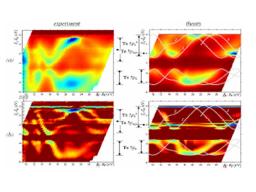
Fig.1 : k// dispersion map of the experimental VLEED spectra. The shaded and white areas show, respectively, the T(E) maxima and minima
energy intervals between the dT/dE extrema reflecting the critical points in 3D final states. Grayscale within the shaded areas characterizes logarithmic d2T/dE2. Dashed lines show the diffraction thresholds E=h2(k//+g)2/2m near which the surface resonances are found
In photoemission, the initial-state k⊥ can be deduced if the final-state surface-perpendicular dispersion E(k⊥) into the crystal bulk is known. The widely used free-electron-like (FE-like) model fails for many quasi 2D systems.[1] Final states can feature dramatic non-free-electron effects, [2] and can undergo significant energy shifts due to band- and k-dependent excited-state self-energy corrections ΔΣ.[3] The photoelectron lifetime damps the final-state wavefunction in the surface-perpendicular direction towards the crystal interior, resulting in intrinsic final-state broadening in k⊥.[4] The PE peaks then reflect the initial-state E(k⊥) average over the broadening interval.
True final-state E(k⊥) dispersions can be obtained using Very-Low-Energy Electron Diffraction (VLEED). In the one-step PE theory the final state can be considered as the time-reversed LEED state. In VLEED the energies of the spectral structures reflect the characteristic points in the final-state E(k⊥) such as the band gap edges, and their broadening and relative amplitudes the corresponding lifetimes. [5]
3D band structure along ΓA of unoccupied and occupied states of the prototype layered material TiTe2 has been studied. The final states in the photoemission process are determined from VLEED using first-principles calculations based on a Bloch waves treatment of multiple scattering. The unoccupied states of TiTe2 feature dramatic non-free-electron effects such as multiband composition and nonparabolic dispersions. The valence band layer-perpendicular dispersions are then determined from a photoemission experiment consistently interpreted on the basis of the experimental final states. The results demonstrate the absence of the Te 4pz* Fermi surface pocket at the Γ point and significant selfenergy renormalization of the valence band dispersions. They reveal limitations of understanding photoemission from layered materials in terms of direct transitions.
REFERENCES :
[1] R. Claessen et al., Phys. Rev. B 54, 2453 (1996)
[2] V.N. Strocov et al., J. Phys. C : Cond. Matter 10, 5749 (1998)
[3] V.N. Strocov, Phys. Rev. B 66, 195104 (2002)
[4] P.J. Feibelman et al., Phys. Rev. B 10, 4932 (1974)
[5] V.N. Strocov et al., J. Phys. C : Cond. Matter 8, 7539 (1996)

Fig.2: Experimental(left) and theoretical (right)PE:(a)Intensity as a function of the initial-state and final-state energies (relative to EF);(b) -d2I/dE2 of the EDCs (-d2I/dE2 < 0 set to zero) on a log scale. Dispersion branches within the Te 5pz and Te 5pz* energy regions show multiband composition of the final state. Lines show
the direct transitions using the theoretical initial and final states
•  Les archives de l'IRAMIS et du DRECAM / Archives of DRECAM and IRAMIS › Matériaux, surfaces et nanostructures
Les archives de l'IRAMIS et du DRECAM / Archives of DRECAM and IRAMIS › Matériaux, surfaces et nanostructures  Physique, chimie, nanosciences et matériaux autour des grands instruments
Physique, chimie, nanosciences et matériaux autour des grands instruments
• Laboratory of Physics and Chemistry of Surfaces and Interfaces • Service de Physique et Chimie des Surfaces et des Interfaces
• Laboratory of Nanostructures Studies and Surface Imagery (LENSIS) • Laboratoire d'Etude des NanoStructures et Imagerie de Surface (LENSIS)










